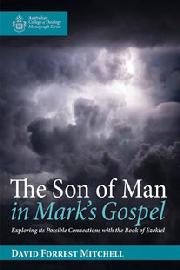 The Son of Man in Mark’s Gospel: Exploring its Possible Connections with the Book of Ezekiel,
The Son of Man in Mark’s Gospel: Exploring its Possible Connections with the Book of Ezekiel,
DAVID FORREST MITCHELL
ACT MONOGRAPH SERIES,
WIPF AND STOCK, 2019
This book achieves what many would have assumed to be unattainable. Despite the immense amounts of scholarly effort invested in the study of Jesus’ use of “Son of Man”, David has contributed something that is not only new but also worth saying—and he has done it in less than one hundred pages! (This is the published version of the dissertation for which he was awarded the Master of Theology by the Australian College of Theology.)
The only surprise about what he says is that it needed to be said. There has been a long-standing consensus that Jesus derived this unusual self-designation primarily from the vision reported in Daniel 7. This leaves many thoughtful Bible-readers wondering why the scholarly eggs have been confined to this one small basket, when there is another that is much bigger and surely no less worthy of attention: the fact that the Lord never addresses Ezekiel by name but always (ninety-three times!) calls him “son of man.”
However, it is one thing to suspect that there might be a link between Ezekiel and Jesus’ use of the term and quite another to show that such a link is probable—and David makes this case in the way a skilful barrister assembles and presents evidence in a trial. He begins with a clear analysis of the state of scholarly discussion (chapter 1) and then explains and justifies the approach his study takes (chapter 2). Then follows the largest chapter, which discusses every “Son of Man” passage in Mark’s Gospel under three headings: the scene; the saying; the emerging picture of the Son of Man. After summarising the results in Chapter 4, there are three chapters which discuss in turn the reasons for investigating the book of Ezekiel (chapter 5); the ways in which it uses the Hebrew form of “son of man” (chapter 6); and then how all of this is similar to and different from what Mark’s Gospel revealed (chapter 7). Chapter 8 assesses the implications of these similarities and contrasts before Chapter 9 gives a brief statement of where the investigation takes us.
As they reach the end of the last page, most readers are likely to be surprised that a discussion of complex issues—which includes a use of the biblical languages— is so clear and readable, and that such a slim volume could cover so much ground without being shallow. They are also bound to be impressed that the argument is so careful and measured, always resisting the temptation to claim more than the evidence allows—so there is no attempt to banish Daniel 7 and install Ezekiel in its place. What it does show very clearly is that Ezekiel now belongs alongside Daniel 7 in any study of Jesus’ use of “the Son of Man.”
Yes, I know that I have not mentioned at all the specific findings of any section of the investigation—and this omission is quite deliberate! If I had given such a summary, you would undoubtedly have reacted just as I would: “That gives me enough—so there’s another one I can leave on the shelf.” But this really is a book that deserves to be read!
ALLAN CHAPPLE, WA
